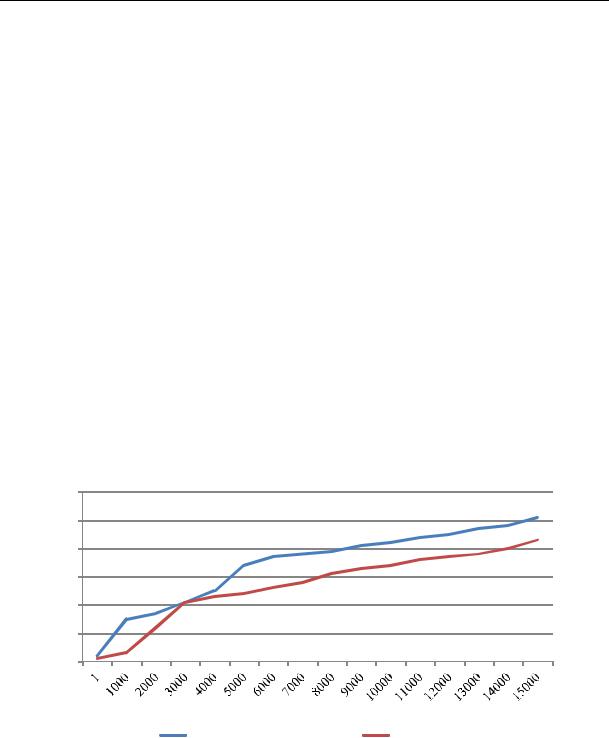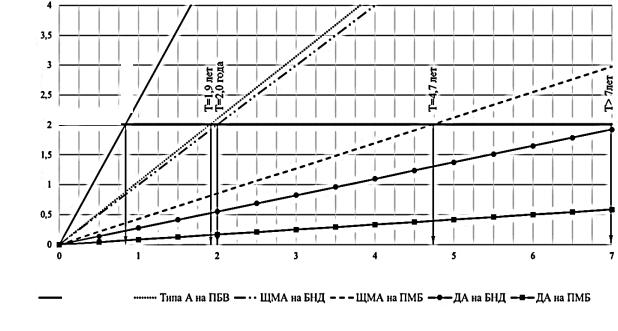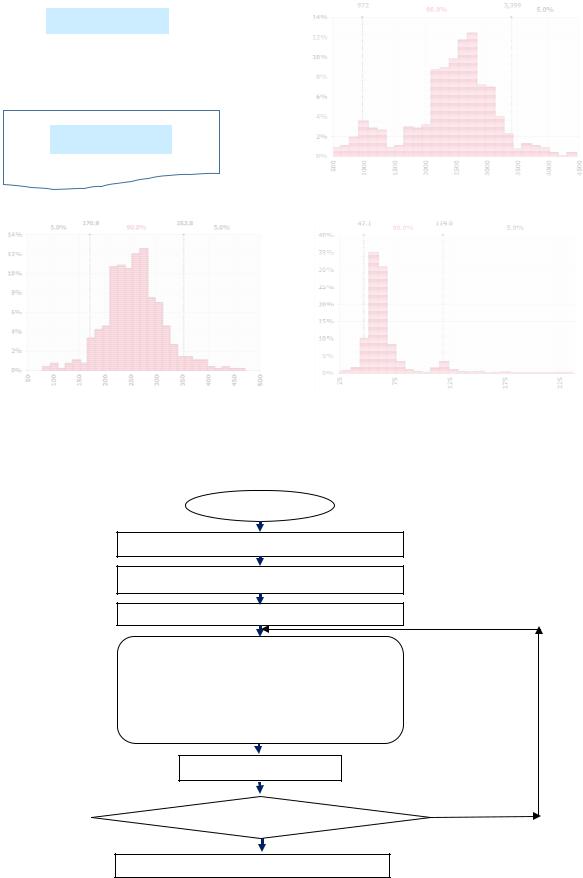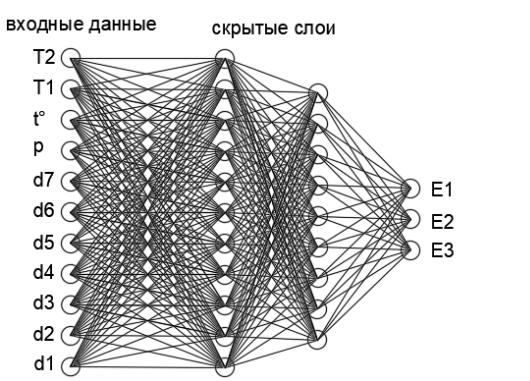
Учебное пособие 2134
.pdf
Russian Journal of Building Construction and Architecture
Hence based on the data of the experimental studies, it was found that for the preparation of draining asphalt concrete mixtures with high physical, mechanical and operational properties, mineral materials using gabbro-diabase are recommended, and the binder content should be 3.7 % with an adhesive additive concentration of at least 0.4 % by weight of organic binder and 3.8 % at a concentration of adhesive additives of 0.3 % of the mass of the organic binder.
3. Predicting the life cycle of the upper surfacing layer. In order to predict the life cycle of the draining asphalt concrete, tests were conducted on the optimized composition of the draining asphalt concrete on mineral material using gabbro-diabase and an organic binder content of 3.7 % with an adhesive additive for rutting resistance.
The preparation of slab specimens for rutting tests was performed on a sector compactor simulating the process of compaction of the asphalt concrete mixture with rollers in production conditions [17, 20].
Prior to the testing, plate specimens were thermostated in a climatic chamber at a temperature of (60±1) °С for 4 hours and then exposed to the action of a wheel for a certain number of cycles [15]. The test results are in Figure 5.
Rutting resistance
|
0,6 |
|
|
0,5 |
0,51 |
mm |
0,4 |
0,43 |
depth, |
0,3 |
|
0,2 |
|
|
Rut |
|
|
|
|
|
|
0,1 |
|
|
0 |
|
Number of runs, cycles
Sample |
1 |
|
Sample2 |
Образец |
|
|
Образец |
Fig 5. Graph of the rutting resistance of draining asphalt concrete using PMB 50/70 with the adhesive additive АМDOR 20Т
The analysis of the research results showed that with the optimal composition of all the components of the draining asphalt concrete mixture, the actual value based on “rutting resistance” averages 0.47 mm.
80

Issue № 2 (46), 2020 |
ISSN 2542-0526 |
When predicting the life cycle of the draining asphalt concrete pavement using the maximum permissible rutting value (2 cm) in compliance with the current regulatory and technical documentation, its operation is possible for more than 7 years without the formation of plastic deformations (see Fig. 6).
Depth of a rut on a road structure surface
Н пред = 20 mm
Type A using VORB
T = 0.8 Years
T= 1.9 Years T= 2.0 Years |
|
|
|
||
|
T= 4.7 Years |
|
|||
|
|
T > 7 Years |
|||
|
|||||
|
|
|
|||
Time of the surfacing repairs, years
|
|
|
|
|
|
|
|
DA |
Type A |
|
CSMAC |
|
CSMAC |
|
DA |
||
using |
|
using |
|
using |
|
using |
|
using |
PBB |
|
VORB |
|
PMB |
|
VORB |
|
PMB |
|
|
|
|
|
|
|
|
|
|
|
|
|
|
|
|
|
|
|
|
|
|
|
|
|
|
|
Fig. 6. Predicted depth of a rut on a road surfacing depending on the type of asphalt concrete: Нпред is a maximum permissible number for the rutting resistance; Т is the life cycle of a surfacing; Type А is a fine-grained dense Type A asphalt; CSMAC is crushed stone mastic asphalt concrete CSMAC-15; DA is draining asphalt concrete DА-15; VORB; PMB is polymer-modified bitumen
Conclusions. The use of an adhesive additive makes it possible to increase the water resistance index based on the Lottman method by increasing the bitumen film on the surface of mineral materials, which in turn leads to an increase in resistance to cracking. In order to increase the resistance of draining asphalt concrete to climatic factors, the content of the adhesive additive should be at least 0.4 %.
The newly developed compositions of draining asphalt concrete with a complex modified binder provide the required performance characteristics, i.e., abrasion, filtration rate and water resistance, during the entire life cycle of the top layer of the coating. The developed compositions increase thelifecycleofthe uppersurfacinglayer andtheturnaroundtime from3––4yearsto 5––7years. The study has shown that application of drainage asphalt concrete on mineral materials using gabbro-diabase or granite is less susceptible to abrasion under the influence of studded tires, which in turn improves the durability of a pavement.
81

Russian Journal of Building Construction and Architecture
References
1.Zolotarev V. A. Dolgovechnost' dorozhnykh asfal'tobetonov [Durability of road asphalt concrete]. Vest. Khar'kov. Vish. shkola. dor. un-ta, 1977, p. 116.
2.Ivanov N. N. Puti uvelicheniya dolgovechnosti asfal'tobetonnykh pokrytii [Ways to increase the durability of asphalt concrete coatings]. Avtomobil'nye dorogi, 1964, no. 1, pp. 21––22.
3.Rebinder P. A. Nauchnye osnovy tekhnologii proizvodstva novykh stroitel'nykh materialov [Scientific basis of new construction materials production technology]. Vestnik AN SSSR, 1961, no. 10, pp. 70––77.
4.Chernov S. A. e.a. Pribor dlya opredeleniya koeffitsienta fil'tratsii obraztsov iz dreniruyushchei asfal'- tobetonnoi smesi –– «PFDA» [Device for determining the filtration coefficient of samples from a draining as- phalt-concrete mixture –– "PFDA"]. Patent RF, no. 35, 2014.
5.Chirva D. V., Chernov S. A. Analiz effektivnosti vliyaniya stabiliziruyushchikh i polimernykh dobavok na fiziko-mekhanicheskie pokazateli shchebenochno-mastichnykh smesei [Analysis of the effectiveness of the influence of stabilizing and polymer additives on the physical and mechanical parameters of crushed stone-mastic mixtures]. Avtomobil'nye dorogi, 2013, no. 8 (981), pp. 70––75.
6.Chernov S. A. Ekspluatatsiya pokrytii avtomobil'nykh dorog iz dreniruyushchego asfal'tobetona [Operation of road surfaces made of draining asphalt concrete]. Rostov-on-don, 2018. 120 p.
7.Shiryaev N. I., Chernov S. A. [Draining asphalt concrete for the top layers of the surface]. Materialy Mezhdunar. nauch.-prakt. konf. «Stroitel'stvo –– 2015» [Proc. “Construction-2015”]. Rostov-on-don, 2015, pp. 54––57.
8.Bredahl C. Construction of Two-Layer Porous Pavements. Danish Road Institute, 2005, pp. 34––68.
9.Gandhi T. Laboratory Investigation of Warm Asphalt Binder Properties –– A Preliminary Investigation. Proc. of the International Conference on Maintenance and Rehabilitation of Pavement and Technological Control. Utah, 2007, pp. 8––10.
10.Hurley G. Evaluation of Evotherm® for use in warm mix asphalt. NCAT report, 2006, pp. 06––12.
11.Huwe L. Performance Related Evaluation of Porous Asphalt Mix Design. Proc. of Malaysian Road Conference. Kuala Lumpur, Malaysia, 1996.
12.Kandhal P. Design, Construction, and Maintenance of Open-Graded Asphalt Friction Courses. Information. Series 115. National Asphalt Pavement Association, 2002, pp. 37––92.
13.Kandhal P. S. and Mallick R. B. Open Graded Asphalt Friction Course: State of Practice. Transportation Research Circular E-C005. Transportation Research Board. Washington, D.C., 1998.
14.Khalid H. Performance assessment of Spanish and British porous asphalts. Performance and Durability of Bituminous Materials. Published by E &FN Spon, London, 1996, pp. 137––157.
15.Klenzendorf J. B. Quantifying the behavior of porous asphalt overlays with respect to drainage hydraulics and runoff water quality. Environ. Eng. Geosci, 2012, no. 18, pp. 99––111.
16.Liu Q. Induction healing of porous asphalt concreate. Wuhan University of technology, 2012, pp. 145––167.
17.Nielse C. Durability of Porous Asphalt –– International Experience. Danish Road Institute Technical Note 41. Road Directorate Ministry of Transport and Energy, 2006.
82
Issue № 2 (46), 2020 |
ISSN 2542-0526 |
18.Pagotto C., Legret V. Comparison of the hydraulic behaviour and the quality of highway runoff water according to the type of pavement. Water Res, 2000, no. 34, pp. 4446––4454.
19.Rogge D. Development of Maintenance Practices for Oregon F-mix. Publication FHWAOR-RD-02-09. Federal Highway Administration, U.S. Department.
20.Suresha S. N. Laboratory and Theoretical Evaluation of Clogging Behavior of Porous Friction Course Mixes. International Journal of Pavement Engineering, 2008, vol. 1, pp. 61––70.
21.Wielinski J. Laboratory and Field Evaluations of Foamed Warm-Mix Asphalt Projects. Transportation Research Record, 2009, no. 2126, pp. 125––131.
83

Russian Journal of Building Construction and Architecture
DOI10.36622/VSTU.2020.2.46.006
UDC 625.7/.8
M. M. M. Elshamy1, A. N. Tiraturyan2
USING APPLICATION OF AN ARTIFICIAL NEURAL NETWORK SYSTEM TO BACKCALCULATE PAVEMENT ELASTIC MODULUS
Al-Azhar University1
Nasr City, Cairo, Egypt
Don State technical University2
Russia, Rostov-on-Don
1PhD student of the Dept. of Highways, e-mail: mm.elshamy85@gmail.com
2PhD in Engineering, Assoc. Prof. of the Dept. of Highways, tel: +7(951)8200303, e-mail: tiraturjan@list.ru
Statement of the problem. The article is devoted to the use of artificial neural networks in solving the problems of processing the results of instrumental recording of bowls of flexible pavement deflections using FWD shock loading settings.
Results. The analysis was carried out, the shortcomings of the existing processing methods were noted, in particular the “backcalculation” method, which consists of a long calculation time, and the instability of the results obtained. The structure of the artificial neural network was built to determine the elastic moduli of the pavement layers. Training of an artificial neural network was carried out using the method of back propagation of error.
Conclusions. The developed neural network has shown good results in training on the test data set, as well as high accuracy of prediction of the elastic moduli of the pavement.
Keywords: pavement, elasticity modulus, artificial neural networks, falling weight deflectometer, backcalculation, deflection bowl.
Introduction. Ensuring the safety of highways is the most urgent task of the road industry of the Russian Federation. Its solution requires a radical revisiting of the existing and longstanding approaches in the field of design, construction and operation of highways including calculation and instrumental foundations. One of the most advanced and promising directions is developing methods for non-destructive testing of the state of non-rigid road pavements, which allows one to solve the issues related to targeted and reasonable assignment of repairs.
© Elshamy M. M. M., Tiraturyan A. N., 2020
84
Issue № 2 (46), 2020 |
ISSN 2542-0526 |
Thus, in the practice of road inspection of the Russian Federation, FWD shock loading devices have become common providing the ability to register bowls of elastic deflections and based on them to determine the elastic moduli of structural layers of non-rigid road pavements by means of a procedure called reverse calculation or “backcalculation” [7––14, 19––21].
This procedure involves identifying actual operational values of the elasticity moduli of the structural layers of non-rigid road pavements from the experimental bowl of elastic deflections recorded on site. The reverse calculation mechanism assumes the need to adjust the experimental bowl in relation to the design constructed according to the mathematical model of the pavement for some “initial values of the elastic moduli of the layers”, which can be design values of the elastic moduli of the layer materials or the values of the elastic moduli or stiffness moduli established under laboratory conditions. Despite its common use, this method has a number of serious limitations and disadvantages including:
––need to verify the design models according to the data of field tests and testing at proving grounds or by means of accelerated testing facilities;
––complexity of constructing dynamic solutions of the elasticity theory for mathematical models of road pavements;
––complexity of implementation of an effective mechanism for correcting the calculated and experimental bowls of elastic deflections, which makes it possible to provide a high counting rate and a small error between the experimental and calculated values of elastic deflections.
In order to address the issue related to adjustment in the global and domestic practice, multiple methods are being employed such as the gradient descent method, method of successive approximations, etc. However, all of these methods have the above drawbacks. An effective solution seems to be using artificial neural networks (ANNs) which have of late received considerable distribution [15––18]. An artificial neural network is a mathematical model as well as its software or hardware implementation building on the principle of the organization and functioning of biological neural networks, i.e., networks of nerve cells [1––3]. Hence the aim of the studies is to develop and train an artificial neural network that allows one to calculate the elastic moduli of the structural layers of non-rigid road pavements according to the bowls of deflections recorded on site. The results of registration of bowls of elastic deflections on the roads of the State Company Russian Highways in the period from 2014 to 2018 have been employed as an experimental foundation for training the artificial neural network.
85

Russian Journal of Building Construction and Architecture
1. General provisions of the use of artificial neural networks. The fundamental unit in the design of artificial neural networks is a neuron itself. At the same time, the artificial neural network itself is a collection of neurons linked to each other by connections. A distinctive feature of neural networks is that they are trained for their correct operation. In the process of training, the neural network is able to identify complex dependencies between input and output data as well as to perform generalization. This means that in case of successful training, the network will be able to yield the correct result using the data that was not included in the training sample as well as incomplete and/or “noisy”, partially distorted data.
Various versions of the implementation of the structure of artificial neural networks allow you to create self-learning networks that involve multiple exposure to a set of input training data, recognition of their common features and subsequent grouping. Other types of neural networks can be programmed to associate previously specified sets of input patterns with corresponding output patterns.
Input
а)
Input layer
Neuron
Hidden layer
Alignment
Output layer
Output
b)
Input
Alignment Summing Transmission
weight function
Fig. 1. Structures (a) and algorithm of operation (b) of the artificial neural network
The most widespread neural network architecture is the so-called multi-level feed-forward network. Such networks consist of several neural layers linked by connections with each characterized by a certain weight w1, w2, … , wn.
Hence when the input signal is supplied, information is transmitted from the input layer of neurons via a number of hidden layers to the output layer. As each element passes, a weighted sum is determined (i.e., the sum of the input signals multiplied by their respective scales).
n |
|
N j wji xi , |
(1) |
i 1 |
|
where xi is a signal passing through into the i-th layer of neurons; wji |
is the alignment scales. |
86
Issue № 2 (46), 2020 |
ISSN 2542-0526 |
Based on the weighted sum, the activation function is calculated whose value is the output of the neuron. As activation operates, the so-called “single hop” function can be used which assigns a discrete value of 0 or 1 depending on the weighted sum. The issues of neural network training are being given special significance. In supervised learning, a set of training data (pairs of input-output patterns) is provided to the network, one example at a time.
Multi-layer artificial neural networks are trained using a technique known as back propagation of errors [5––6]. Its major point is that the error between the calculated and target patterns of the output data spreads in the opposite direction from the output neural layer via the hidden layers to the input in compliance with the existing connection scales. Then the scales of the connections are changed, which help to reduce the learning error. If training is successful, the link scales reach values that minimize the inference error (commonly expressed as the standard deviation) for all inputs in the training set.
Thus, the error backpropagation algorithm allows distribution of its accumulation between different layers of an artificial neural network and is characterized by a high speed.
2. Implementation of the reverse calculation of the elasticity moduli of structural layers of non-rigid road pavement based on an artificial neural network. In this study, a standard non-rigid pavement structure was investigated including a pavement layer, foundation and subgrade soil (Fig. 2a). For each of the pavement layers, the permissible limits of change in their elastic moduli (E1, E2, E3) were taken. For asphalt concrete layers (E1) these values were 500––4500 MPa, for the foundation layer (E2) –– 80––500 MPa, for subgrade soil (E3) 40––150 MPa (Fig. 2).
In order to train the artificial neural network, the values of vertical deflections measured on site, load, pavement temperature and layer thickness were employed. Figure 3 shows a learning algorithm for the artificial neural network. The development of the structure and operation of the artificial neural network was performed in the NeuralNetworks software package. This artificial neural network contains two hidden layers with 20 neurons.
The set of the training data used in this study included the results of calculating the elastic moduli of structural layers of non-rigid road pavements conducted in a specialized software package supplied with an FWD Primax shock loading installation on 581 road sections managed by the State Company Russian Highways. The dataset was split into two blocks. One of them which includes 80 % of all the measurements was used to train the neural network, and the second, which is 20 % of the total, for testing the results obtained using the artificial neural network.
87

Russian Journal of Building Construction and Architecture
a) |
|
|
|
|
|
b) |
||
|
|
|
|
|
|
|
|
|
|
|
|
|
|
|
|
|
|
|
|
E1 |
= 900 – 4500 МПа |
|
|
190–220 mm |
|
|
|
|
|
Покры |
- |
|
observationsof |
б |
|
|
|
|
|
|
|
|
|
|
|
|
E2 |
=80 – 500 МПа |
- |
350–460 mm |
|
||
|
|
|
Основа |
|
|
|||
|
|
|
|
|
|
|
Number |
|
|
|
E3 = 40 – 150 МПа |
|
∞ |
|
|||
|
|
|
Грунт з. |
|
|
|
||
|
|
|
|
|
|
|
|
Elasticity modulus of asphalt concrete (E1), MPa |
в |
|
|
|
|
г |
|
||
Number of observations |
|
|
|
|
Number of observations |
|||
|
Elasticity modulus of asphalt concrete (E2), MPa |
|
Elasticity modulus of asphalt concrete (E3), MPa |
|||||
Fig. 2. Input data for training the artificial neural network а) road pavement structure;
b) – d) distributions of the elastic moduli of asphalt concrete layers, foundation, subgrade soil, respectively
Start
Preparing the training samples
Identifying the input and output layers
Designing the network architecture
Training the network by changing
–training rate,
–impulse coefficients,
–alignment scales,
–number of hidden layers,
–number of neurons in the hidden layers,
–type of the activation equation
Network validation
Has the goal been achieved? Yes
No
Network is ready for the calculation
Fig. 3. Designing the artificial neural network
88

Issue № 2 (46), 2020 |
ISSN 2542-0526 |
Input data |
|
|
|
Hidden layers |
|
|
|
|
|
|
|
Output data
Fig. 4. The structure of the neural network for identifying the elastic moduli of the structural layers of non-rigid road pavements (T1, T2 are the thickness of the layers of asphalt concrete and the foundation of the pavement, tº is the temperature on the surface of the pavement, p is the pressure on the pavement, d1 ... d7 are the results of measuring elastic deflections under the sensors-geophones, E1, E2, E3 are the moduli of elasticity of asphalt concrete layers, foundation and subgrade soil, respectively)
Figure 5 shows the results of training the neural network and of test calculations compared with the values of the elastic moduli calculated in the PRIMAX software package. As can be seen from the above graphs, the results of predicting the elastic moduli performed using an artificial neural network are quite similar to the values identified in the specialized software package, which is confirmed by the high values of the coefficients of determination (R2 = 0.97––0.99 –– for asphalt concrete layers and the base of the pavement, R2 = 0.95––0.99 for subgrade soil).
At the same time, use of artificial neural networks for the calculation can considerably increase the speed and stability of the calculation of the operational values of the elastic moduli of the layers of non-rigid road pavements. The speed of calculation using an artificial neural network is 7 times higher than that of correcting bowls of elastic deflections in the Primax software package and more than 15 times of that of the calculation in the AEM software package [4] developed at the RSSU.
89
